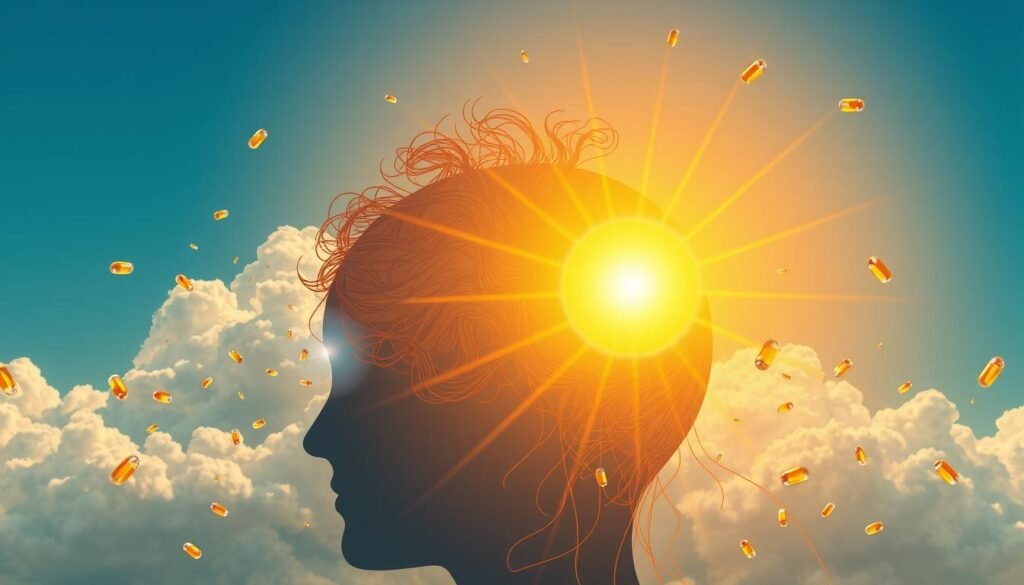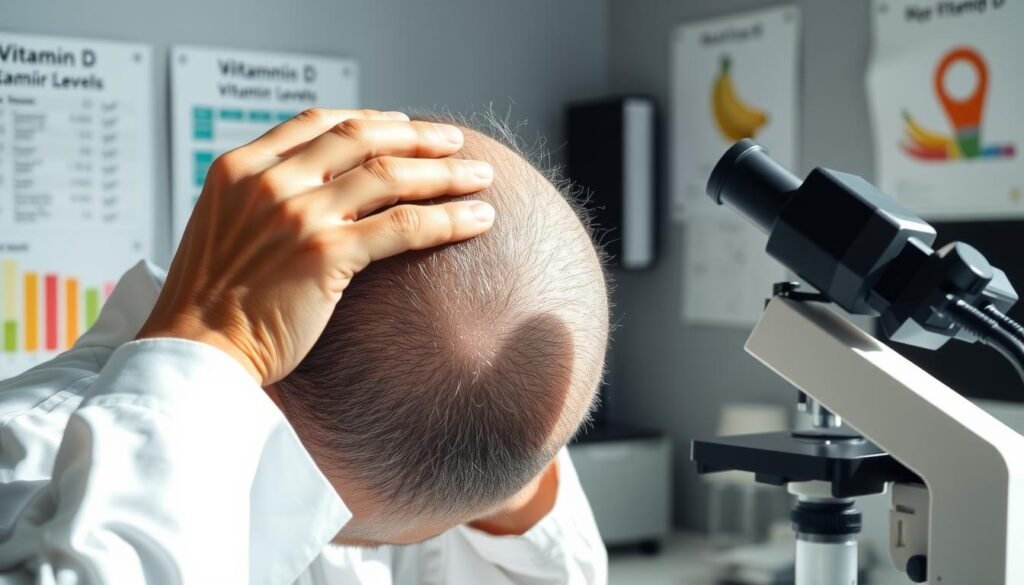Did you know 42% of men aged 18 to 49 suffer from hair loss? This isn’t just a statistic. It shows the widespread concern about hair health linked to what we eat and don’t eat. One key factor is a lack of vitamin D, found to play a big role in hair loss.
Studies show that not having enough vitamin D can lead to hair problems like androgenetic alopecia and alopecia areata. Knowing about this deficiency is important to fight hair loss effectively. It’s not just about looking good. Low levels of vitamin D could point to other health issues too.
Key Takeaways
- Vitamin D deficiency is linked to various forms of hair loss, including androgenetic alopecia.
- A significant percentage of the population is unaware of their low vitamin D status, which impacts hair health.
- Understanding vitamin D’s role is crucial as it affects the anagen and telogen phases of hair growth.
- Deficiency symptoms can encompass more than just hair loss, including joint pain and muscle weakness.
- Maintaining adequate vitamin D levels can promote healthier hair follicles and enhance scalp health.
- Research continues to emerge, indicating a promising future for vitamin D deficiency treatments in relation to hair loss.
- Dietary sources and supplements are vital for replenishing vitamin D and should be part of a hair care routine.
Understanding Vitamin D and Its Importance
Vitamin D is crucial for our health. It helps with various body functions and keeps us healthy. Many people don’t know what is vitamin d or how it impacts our wellbeing. It’s especially important for our hair health. It helps control calcium and boosts immune function.
What is Vitamin D?
Vitamin D comes in two types: D2 and D3. D3 comes from sunlight on our skin. D2 comes from plants. Not having enough vitamin D can cause health problems. This includes hair loss due to vitamin D deficiency. Research shows a link between low vitamin D and hair loss types like androgenetic alopecia.
How Vitamin D Functions in the Body
Vitamin D keeps calcium and phosphate levels right for healthy bones and cells. It’s also key for hair follicle health. If we don’t get enough, our hair growth cycle can be disrupted. This affects the new hair growth phase. Studies show people with low vitamin D often have thinning hair.
The Role of Vitamin D in Hair Growth
Vitamin D is important for hair follicle health and growth. Not having enough can slow hair growth and lead to loss. In studies, about 81.8% of people with hair loss had low vitamin D. Some doctors suggest vitamin D supplements to help prevent hair loss.
Research indicates vitamin D supplements can restart hair growth in months. For more info, check the detailed article here.
The Connection Between Vitamin D Deficiency and Hair Loss
The link between low vitamin D and hair loss is getting more attention. Studies show that vitamin D is key for healthy hair. We’ll look at how it affects hair growth and review the latest findings about vitamin D and hair loss.
How Vitamin D Affects Hair Follicle Cycling
Vitamin D is important for hair cycle regulation. Not having enough can mess up the cycle. This leads to more hair shedding and loss. Hair cells need vitamin D to grow well. So, having enough vitamin D is essential for keeping hair healthy and growing properly.
Research Findings on Vitamin D and Hair Loss
Studies have found that people with low vitamin D have more hair loss issues. Those with alopecia areata, a hair loss condition, often have much lower vitamin D levels. While adding vitamin D might help, we need more research. Scientists are still looking into how vitamin D can promote fuller, healthier hair.

Hair Loss from Vitamin D Deficiency: Understanding the Symptoms
Knowing the signs of vitamin D deficiency is key to tackle hair loss. Symptoms can be obvious and worrying. It’s important to see how vitamin D levels affect hair health.
Common Symptoms of Vitamin D Deficiency
Vitamin D shortage can lead to different health issues, such as:
- Thinning hair or increased hair shedding
- Fatigue and muscle weakness
- Delayed wound healing
- Lowered immunity
- Low mood and depression
Thinning hair suggests you might need more vitamin D. Studies show not having enough can cause hair to fall out. This can make people feel less confident and happy.
The Link Between Hair Thinning and Vitamin D
Research links vitamin D levels to hair health. Not having enough can mess up the hair growth cycle. This makes hair shed more and thin out. A study in 2021 found vitamin D deficiency could lead to common hair loss conditions.
If you’re losing hair, check your vitamin D. Getting tested, enjoying the sun, and eating right can help. For tips on vitamins and hair loss, check out this site.

Identifying Your Risk for Vitamin D Deficiency
Knowing what increases your risk of vitamin D deficiency is vital for hair health. Many don’t know they’re at risk, which can lead to vitamin D deficiency and hair loss.
Factors Contributing to Vitamin D Deficiency
Several things can cause vitamin D deficiency, affecting many people. These include:
- Limited sun exposure: If you live where there’s little sun, you may not make enough vitamin D.
- Darker skin: More melanin makes it harder for your skin to absorb sunlight.
- Obesity: Fat tissue holds onto vitamin D, keeping it from circulating in your blood.
- Advanced age: Older people often can’t make as much vitamin D from sunlight, increasing their deficiency risk.
- Gastrointestinal issues: Problems like Coeliac disease can stop you from getting vitamin D from food.
Who is at Higher Risk for Hair Loss?
Certain groups might be more likely to lose hair due to vitamin D deficiency. They include:
- Older adults often show signs of vitamin D deficiency and hair loss.
- People who eat a vegan or vegetarian diet might not get enough vitamin D.
- Those with chronic conditions that affect how nutrients are absorbed.
It’s important to be aware of these risks. Keeping an eye on your health helps prevent vitamin D deficiency and hair loss.
| Risk Factor | Impact on Vitamin D Levels | Potential Consequence |
|---|---|---|
| Limited Sun Exposure | Decreased vitamin D production | Higher risk of deficiency |
| Darker Skin | Lower absorption of sunlight | Increased deficiency risk |
| Obesity | Vitamin D sequestration in fat tissue | Potential for reduced serum levels |
| Advanced Age | Reduced synthesis capability | Increased risk of deficiency |
| Gastrointestinal Issues | Impaired nutrient absorption | Risk of deficiency and related issues |
How to Diagnose Vitamin D Deficiency
To find out if you’re lacking vitamin D, it’s crucial to assess symptoms and get tested. This is especially true for those noticing hair loss. Knowing the right tests can help you understand your health better and guide you in managing it effectively.
Tests for Vitamin D Levels
A blood test is the main way to check for vitamin D deficiency. It looks at the amount of 25-hydroxyvitamin D, a key form of the vitamin. Ideal levels are between 30-60 ng/ml. Testing is key because low vitamin D can be hard to notice. Sadly, about 1 in 4 adults in the U.S. have low vitamin D. This makes testing important, especially for those losing hair due to this deficiency.
Consulting Your Healthcare Provider
If you think you might be low in vitamin D, see your doctor. They can make sense of your test results and suggest the best action plan. This step is critical, not only for hair loss but to uncover any deeper health issues. Factors like weight, skin color, and certain conditions can affect your vitamin D levels. Working with your doctor can help you find ways to improve your vitamin D, for better overall health. For more on spotting a vitamin D deficiency, visit this source. It’s a reminder of how vital vitamin D is to various parts of our health.

Treating Vitamin D Deficiency for Healthy Hair
Vitamin D deficiency greatly affects hair health. You can tackle this through diet changes and supplements. Knowing where vitamin D comes from aids in fighting hair loss effectively.
Dietary Sources of Vitamin D
Adding vitamin D-rich foods to your diet boosts your health and hair. Great sources include:
- Fatty fish, such as salmon and mackerel
- Egg yolks
- Fortified dairy products, including milk and cheese
- Fortified plant-based milk alternatives
- Mushrooms exposed to sunlight
Eating these foods daily can reduce vitamin D deficiency and help your hair grow. Consistently including them can improve the hair loss vitamin D connection.
The Role of Supplements in Treatment
Sometimes, food alone can’t fix vitamin D deficiency and hair loss. This is especially true for those with large deficits. Adults should get 600 IU of vitamin D daily, says the National Institutes of Health. However, exact needs may differ. Supplements are key for folks who are very low in vitamin D.
A typical treatment starts with a six-week high-dose of vitamin D3, at 50,000 IU weekly. Then, a maintenance dose of 10,000 IU per week follows for months. This method boosts vitamin D levels in the blood, which is vital for hair growth. Many see better hair growth with this treatment.
| Vitamin D Level | Action Recommended |
|---|---|
| Below 20 ng/mL | Consider high-dose supplements |
| 21-29 ng/mL | Increase dietary sources |
| 30-39 ng/mL | Monitor levels, adjust as needed |
| 40-100 ng/mL | Maintain current regimen |
By changing what you eat and possibly using supplements, you can fight vitamin D deficiency linked to hair loss. Taking these steps leads to healthier hair and overall health. It shows how important vitamin D is for the body.
Strategies to Prevent Vitamin D Deficiency
To stay healthy, it’s crucial to avoid vitamin D deficiency. Vitamin D is important for keeping hair follicles healthy. This helps to stop hair loss caused by a lack of vitamin D. You can do this by getting sunlight and eating foods high in vitamin D.
Importance of Sun Exposure
Getting sun is a key way to get vitamin D. Spending about 10 to 15 minutes in the sun each day works for most. But, people with darker skin may need a bit more time. Getting enough sun, especially in warmer months, helps keep your vitamin D levels up. This is a big part of avoiding vitamin D deficiency.
Maintaining a Balanced Diet Rich in Vitamin D
Eating well also fights vitamin D deficiency. Foods like fatty fish, fortified milk, and egg yolks are full of vitamin D. By adding these foods to your diet, you’ll get the vitamins you need. Pairing this with enough sun makes a great plan to stop vitamin D deficiency and prevent hair loss.
Hair Loss Due to Vitamin D Deficiency: Surprising Facts
Vitamin D deficiency and hair loss are closely linked. Vitamin D and hair loss research trends show that this vitamin is key for healthy hair follicles. Knowing this can help people take better care of their hair.
Research Trends in Vitamin D and Alopecia
People with hair loss often have low vitamin D levels. This is linked to conditions like alopecia. Vitamin D is crucial for hair growth, helping keep hair thick and healthy. It’s important to check vitamin levels if you’re losing hair.
Other Deficiencies Linked to Hair Loss
Hair loss isn’t just about vitamin D. Lack of vitamin B12, biotin, and iron can also cause it. A diet full of these nutrients is key for hair health. To keep hair healthy, eat a variety of nutrient-rich foods.
Looking after your vitamins can help your hair. For more tips on avoiding hair loss due to vitamin deficiencies, check here.
Conclusion
Talking about the vitamin D deficiency hair loss connection is key in battling hair loss. Studies and cases show that having enough vitamin D matters a lot for hair health. For example, a 41-year-old man saw his hair grow back after taking vitamin D3 supplements. This shows how well it works.
We need to understand how vitamin D helps hair grow and the dangers of not having enough. This knowledge lets people act early. They can eat foods that are good for them or take supplements to stop hair loss.
More research will tell us more about how vitamin D affects hair. But, if you’re losing hair, talk to a doctor and check out treatment options. These might be changing what you eat, living differently, or taking special supplements for your needs.